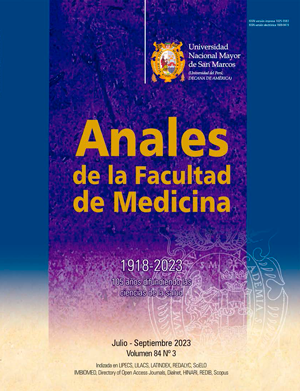Determination of transgenicity and verification in the labelling of industrialized corn foods in retail outlets in metropolitan Lima
DOI:
https://doi.org/10.15381/anales.v84i3.25207Keywords:
Zea mays, Food, Labeling food, Organisms Genetically Modified (source: MeSH NLM)Abstract
Consumption of transgenic foods constitutes a potential health risk. However, in Peru there is a lack of updated and reliable information on the presence of transgenics in food and on the relevant data on their labeling; in the same way about the food consumed by animals for supply, whose products are going to be ingested by humans. Objetive. To determine the transgenicity, through the detection of the 35S promoter, in industrialized corn food products for human and animal consumption, which are marketed in Lima and to verify if the labeling mentions whether or not it contains transgenic sequences. Methods. 30 food samples for human consumption and 10 for consumption by animals for production were analyzed; and the labeling was revised. The Dneasy Mericon Food kit was used for DNA extraction, the Real Time-PCR method for P35S detection using the Mericon Screen 35S kit, and the Mericon Quant Mon 810 kit to determine the copy concentration. Results. P35S was detected in 66,66% of the samples for human consumption, and in 90.00% of the samples for animal consumption. The labeling of 100% of the samples for human and animal consumption does not mention whether or not it contains transgenic components. Conclusions. The detection of transgenic content in the majority of industrialized corn foods for humans and animals demonstrates the need to mention them on the label and the implementation of a demanding policy on food biosafety.
Downloads
Published
Issue
Section
License
Copyright (c) 2023 Anales de la Facultad de Medicina

This work is licensed under a Creative Commons Attribution-NonCommercial-ShareAlike 4.0 International License.
Those authors who have publications with this magazine accept the following terms:
- Authors will retain their copyrights and guarantee the journal the right of first publication of their work, which will be simultaneously subject to Creative Commons Attribution License that allows third parties to share the work as long as its author and its first publication this magazine are indicated.
- Authors may adopt other non-exclusive licensing agreements for the distribution of the version of the published work (eg, deposit it in an institutional electronic file or publish it in a monographic volume) provided that the initial publication in this magazine is indicated.
- Authors are allowed and recommended to disseminate their work over the Internet (eg: in institutional telematic archives or on their website) before and during the submission process, which It can produce interesting exchanges and increase quotes from the published work. (See El efecto del acceso abierto ).















